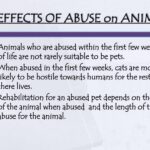Animal cruelty is a distressing reality that plagues societies across the globe, and the legal ramifications for such actions can be as varied as the acts of cruelty themselves. In the United States, the laws governing animal cruelty differ significantly from state to state, both in terms of definitions and penalties. This article delves into how long individuals may face incarceration for committing acts of animal cruelty, exploring the minimum and maximum sentencing guidelines, the motivations behind these laws, and the broader implications for society.
At the heart of the legal framework surrounding animal cruelty are the various statutes that define the nature of such offenses. Most states categorize animal cruelty into two main classifications: misdemeanor and felony. Misdemeanor offenses often involve acts of neglect or minor abuse and are generally punishable by short-term imprisonment, fines, or both. In stark contrast, felony offenses include severe cases of intentional harm, torture, or death of an animal, and typically attract significantly harsher penalties.
In a number of jurisdictions, the minimum sentence for misdemeanor animal cruelty can range from a slap on the wrist, such as a few days in jail or a small fine, to more substantial sentences, including several months of incarceration. For example, some states impose a minimum sentence of up to six months for repeat offenders or for those who exhibit extreme negligence. The rationale behind these minimum sentences is to acknowledge the severity of the offense while also allowing for the rehabilitation of offenders.
Felony charges, on the other hand, present a markedly graver outlook. In most states, the penalties for felony animal cruelty can lead to imprisonment ranging from one year to several years, depending on the specifics of the case. Some jurisdictions even impose maximum sentences that extend up to ten years or more, particularly in heinous cases involving organized abuse or significant suffering inflicted on animals. Notably, certain states have begun to implement mandatory minimum sentences for serious offenses, reflecting a growing societal intolerance for animal cruelty.
The rationale for such stringent laws cannot be overstated. The treatment of animals often serves as a reflection of a society’s moral fibers. As the public becomes increasingly aware of the profound emotional and psychological capacities of animals, there is a rising insistence on establishing legal barriers that protect these vulnerable beings. The laws, therefore, not only serve to penalize offenders but also to signify a collective ethical stance against cruelty.
However, the patchwork nature of animal cruelty laws across the nation raises important questions. Why do some states have more rigorous punishments while others remain lenient? The answers lie in a complex amalgam of cultural perceptions, historical context, and advocacy efforts. In regions where animal rights organizations are active and vocal, the legal system often reflects a stronger protective stance toward animals. Conversely, in areas where traditional views on animal ownership prevail, laws may not prioritize animal welfare as keenly.
Aside from the penalties associated with being convicted of animal cruelty, it is essential to consider how these provisions impact society. Public awareness campaigns and the increasing visibility of animal rights issues often correlate with legislative changes. The fervor surrounding cases of extreme cruelty can galvanize public opinion, leading to greater scrutiny of existing laws and, ultimately, reform. The surge in social media awareness campaigns and documentaries illuminating the brutality of animal abuse acts has catalyzed both public outrage and policy reform.
Interestingly, the incarceration of animal abusers raises another significant discussion point: recidivism. Studies have indicated a persistent pattern among those convicted of animal cruelty offenses, prompting discussions about rehabilitation and prevention. Some advocates argue for the implementation of educational programs targeting violators rather than solely punitive measures. There is a belief that by addressing the underlying reasons for such behavior—whether due to socioeconomic factors, psychological issues, or a lack of knowledge—intervention could prevent future cruelty. Such approaches could contribute to a multifaceted strategy that prioritizes long-term animal welfare over mere punishment.
As legal standards evolve, so does public perception. A growing number of citizens are recognizing the intrinsic value of animal life and the necessity for robust protections. State laws are beginning to reflect this shift, offering hope that a widespread cultural change could lead to a more empathetic society. This evolution also severs the notion that animal cruelty is merely a personal issue; rather, it illuminates systemic problems, urging communities to be more vigilant and proactive in their engagement with animal welfare.
In conclusion, the question of how long one goes to jail for animal cruelty in the U.S. is intrinsically linked to broader societal values and legal complexities. Whether facing misdemeanor charges with minimal penalties or felony convictions carrying lengthy sentences, offenders confront the consequences of their actions within a framework that continuously adapts to societal expectations. As discussions around animal welfare continue to grow in prominence, the hope persists that legal reform will align with the ethical treatment of all living beings, ensuring that justice for animals is not only a penalty but a moral imperative.







